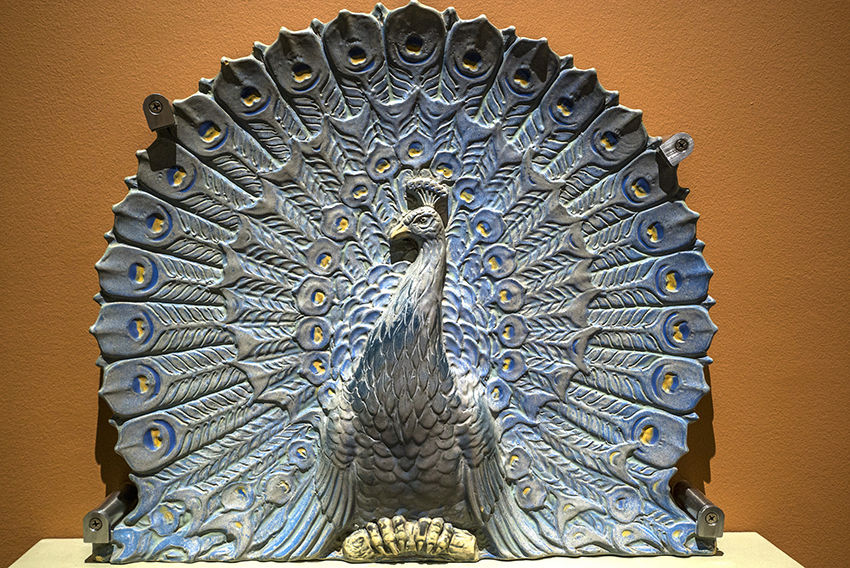The Pasadena Museum of History is featuring an exhibit, extended by popular demand through March 12, called “Batchelder: Tilemaker.”
Ernest A. Batchelder (1875-1957) was an Arts and Crafts tilemaker who lived in Pasadena’s Lower Arroyo Seco and made fountains, fireplaces and fixtures that can still be spotted in craftsman-style bungalows and at various sites throughout the Southern California area and beyond.
The exhibit celebrates the recent donation to the museum by Robert Winter, Ph.D., of a collection of Batchelder tile and archives. Since 1972, Winter has owned and lived in the house on what is now South Arroyo Boulevard where Batchelder built his first kiln, and where he lived during the years his design and tile business thrived.
Winter, a premier Batchelder expert, curated the exhibit, authored the accompanying book and figures prominently in the 15-minute documentary film that orients museum visitors to Batchelder’s life, importance and work.
Born and raised in the Nashua, New Hampshire area, Batchelder moved to Pasadena in 1901and became director of art at Throop Polytechnic Institute (the forerunner to what is today the California Institute of Technology).
But his spirit was restless, and through his travels to the Cotwolds town of Chipping-Camden, and his association with the Boston Society of Arts and Crafts and the Handicraft Guild in Minneapolis, he formed the resolve to give up his secure teaching position.
A hundred years ago, lovers of wood, clay and paint were chafing against the homogenized cheapness of factory-produced goods. Batchelder’s interest in the Arts and Crafts movement was inspired by the ideals of medievalism, with their guilds, mythical animals and tales of knighthood and chivalry. “The dignity of labor is of the mind and heart,” he observed, “not of the hand alone.”
In the early 1900s, Pasadena’s Arroyo — the area along the ravine that runs down from the San Gabriel Mountains through the western part of the city and south through town — was a thriving center for the movement.
Batchelder bought a piece of land there, envisioning a “productive workshop and school” in which “works would be executed in copper and silver, jewelry, enameling, leather and pottery.” In September 1909, he secured a permit to build a six-room, $2,600 frame bungalow. Noted Winter, “Batchelder’s design for his house used the dark-shingled, Swiss-chalet style we now call ‘craftsman’ to harmonize with its sylvan setting.”
In November 1910, Batchelder built a $300 shed in the backyard where he installed a single kiln. His tile-making business had begun.
At the beginning, he considered making even 12 six-inch tiles at a single process to be “quantity production.” By around 1912, however, the tiles — Byzantine birds, Viking ships, California missions — had become popular enough that the business moved to larger quarters to a site on Pasadena’s Broadway (now Arroyo Parkway).
As Winter observed, “Batchelder’s heart was in design — not in theory.”
“If you can appreciate and catch something of the grace and beauty of line in a simple wayside weed,” Batchelder wrote, “nature will yield you more in the way of suggestions for further work than if you sit down to the joyless task of torturing some gorgeous hothouse flower into conventional lines.”
In 1912, he married pianist Alice Coleman, whose legacy also lives on: the Coleman Chamber Music Association series that she started in 1904 continues to this day at Caltech. The Batchelders installed a keyboard in their beautifully tiled porch, where Alice performed her finger-strengthening exercises.
For those of us who thrill to rustic cedar shakes, dark unpainted wood beams, sleeping porches and the dreamy shade of live oaks, Batchelder’s tiles seem so beautifully evocative that you could almost eat them. Their muted, matte-finished colors — azure-dusted mauve, sea-green blue — were compared to those of a Persian rug “which do not admit of positively unharmonious combinations.”
The Batchelder-Wilson Company, as it came to be known, made fireplaces, fountains, bathrooms and fixtures that were affordable to those of modest means: “A fireplace is not a luxury; it is a necessity — because it adds to the joy and beauty of living,” Batchelder wrote.
One of its biggest assignments was the now long-gone Dutch Chocolate Shop in downtown Los Angeles, “a kind of German bierstube,” wrote Winter, “with arches and vaults, covered with tiles.” You can still admire his handiwork in the lobby of the historical landmark Fine Arts Building (1925) on West Seventh Street in downtown L.A., another of his finest installations.
The 1920s were its heyday. The Depression, sadly, effectively wiped the company out.
Walking the Lower Arroyo in the shade of today’s olive and sycamore trees, however, snowmelt murmuring down the flood channel after our recent rains, it’s easy to let the imagination wander back 100 years.
Up above, the lovingly tended home where Batchelder once lived shelters its own memories. Set into the metalwork of the redwood front door is a tile from one of his mentors, Henry Mercer, bearing the inscription, “Fluminis impetus letificat civitatem dei.”
The quote is from Psalm 46 and translates to: “There is a river, the streams whereof shall make glad the City of God.”
Heather King is a blogger, speaker and the author of several books.
Interested in more? Subscribe to Angelus News to get daily articles sent to your inbox.

